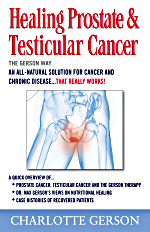| |
Archived from
Charlotte Gerson's booklet

Story
Twenty-one
years ago, in April 1981, Art was 52 years old when
he presemed to the physicians of the Gerson Hospital in Mexico,
with a biopsy-proven adenocarcinoma of the prostate. He had a
17-year history of spastic bowel, hypoglycemia, and an allergy to
penicillin. He also gave an account of an accident that resulted in
painful herniated discs in rhe lower spine and neck pain, for which
he was given Darvon, Robaxin, Talwin, Emperin and Emperin
with Codeine.
In the late 1970s he had a classic history of renal colic, with
right flank pain radiating to the groin, associated with recurrent
gross hematuria (blood in the urine) and constant urge to void.
His urologist in Santa Barbara felt that he must have passed a
stone from the lower ureter through the bladder, but the patient
denies this.
In April 1980 the patient experienced disturbing prostate pain,
with interrupted flow of urine. In early 1981 he suffered from
intermittent severe prostatic pain, for which Percodan was prescribed.
He admitted to dysuria (painful, difficult urination ),
nocturia (urination during the night), and increased frequency and
urgency of urination which had become more and more pronounced
over a one month period. His Santa Barbara urologist
was convinced that he had passed numerous calculi (stones ), but
the patient again denied this. At that time he had lost fifty pounds,
his weight having dropped to 150 Ibs. (height 5'9") from 205 lbs.
His prostate, on palpation, was firm and indurated (hardened ),
raising the slight suspicion of a malignancy.
The patient was referreed for biopsy on April 2, 1981; the result
confirmed an adenocarcinoma of the prostate, Gleason* Grade 2.
His doctor prescribed tetracycline for several weeks and suggested
surgery and a typical management for prostate cancer, but Art
refused.
Instead, he arrived at the Gerson Therapy Center in Mexico on
April 17, 1981. He was anxious, easily fatigued, and reported
relentless severe pain. Since a biopsy two weeks earlier he had
received no intervening management. The treatment was started
immediately, with excellent compliance and good response. After
only 48 hours of treatment with the Gerson diet therapy, the
patient reported relief from his pain. His Percodan was discontinued.
Within two weeks his urine was free from occult blood.
At present, the patient is healthy and busily employed, with no
signs of disease.
This is how Art describes his experience:
"I've never had any symptoms of hypertension, spastic bowel
or herniated discs since I went on the therapy. Prior to starting on
the Gerson Therapy in 1981, it had been blood and pain for two
years, followed by severe pain. But once I started on the therapy,
the pain never came back, to this day. The bloody urine was
cleared up almost immediately - gone by the second urinalysis.
The Gerson doctor examined me after two weeks of treatment and
found that the nodule had softened.
I feel great now. I was suddenly popular with a number of
ladies. In fact, shortly after my wife left, I discovered that the
machinery was intact and functioning, and I felt like I was fifty-five
going on sixteen. I'm sure glad I never had that surgery."
There is an amusing sequel to Art's remarkable recovery. At the
height of his pain, caused among other things by his herniated
discs, he was practically unable to walk, with his thigh muscles
severely atrophied. As a result he was put on full disability pay.
On regaining his health, as shown by his X-rays, [his discs
restored] it was assumed that the benefits would end. However,
the relevant authority declared that such healing was 'impossible'
and continued to pay.
_____________________________________________________
*The Gleason Rating System is the measure of prostate cancer by stage and
grade .
The scale goes from 1-10, 10 being the most advanced.

|
|
